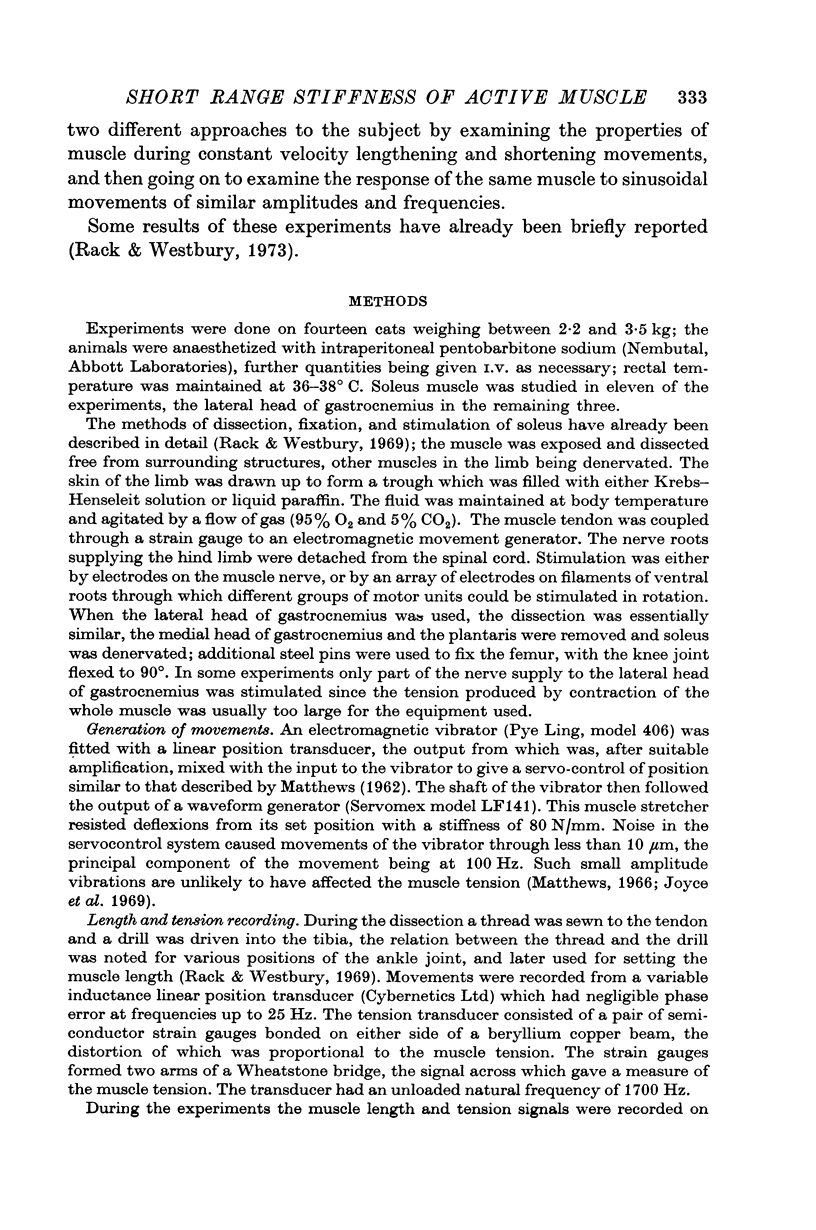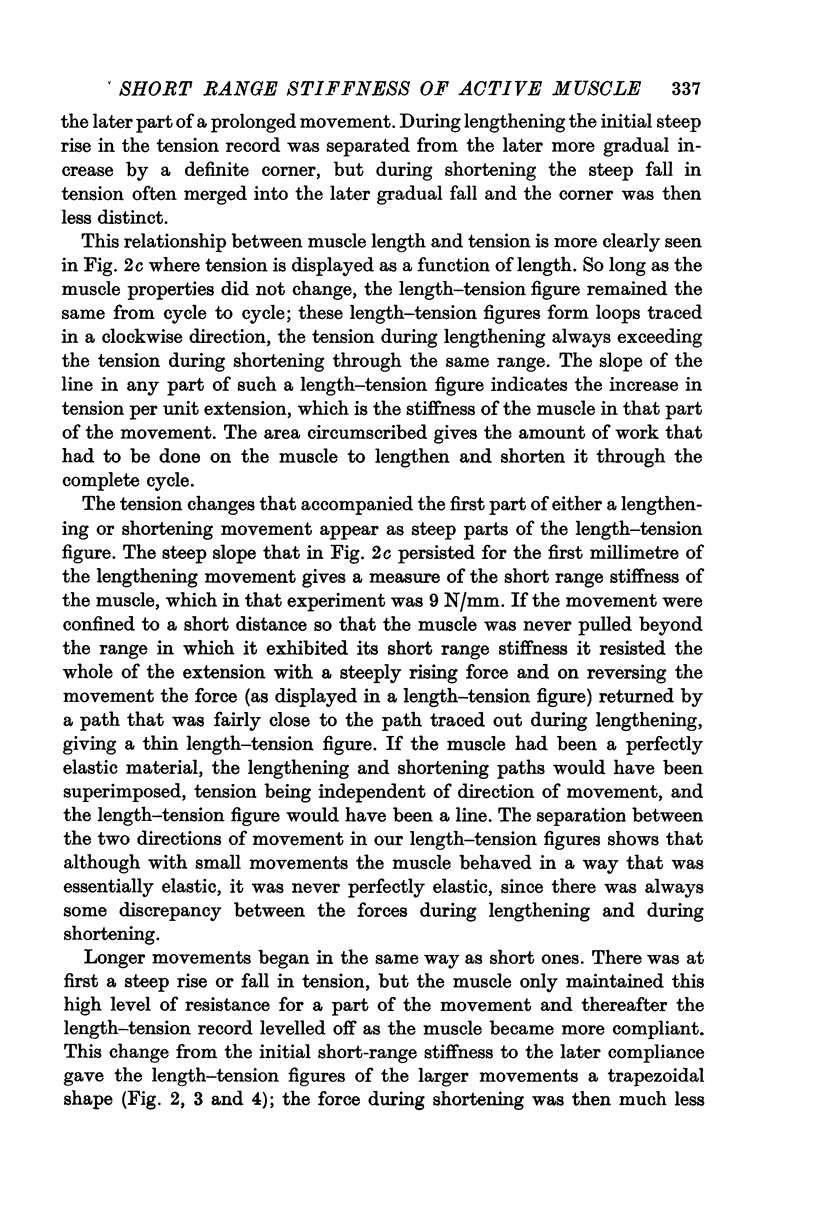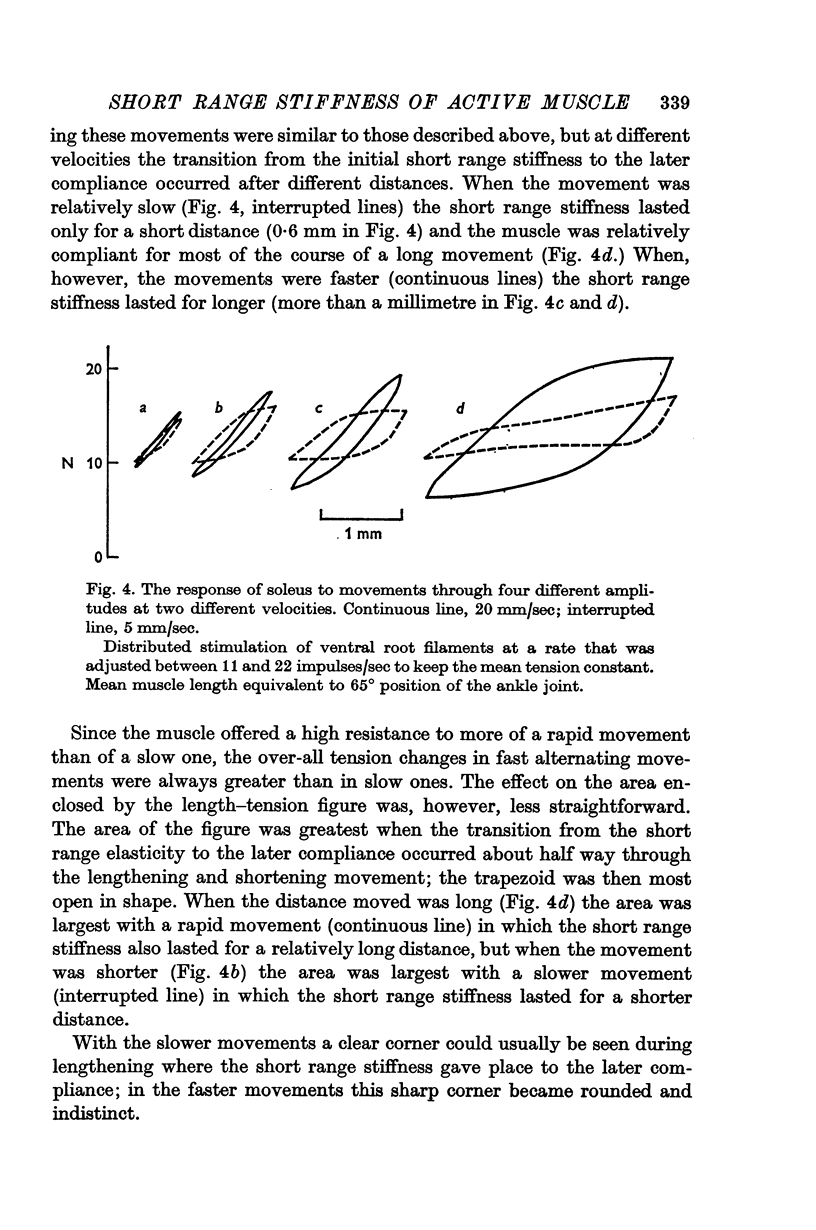Abstract
1. The tension in tetanized cat soleus and lateral gastrocnemius muscles was measured during alternating lengthening and shortening movements. Sinusoidal movements were sometimes used; on other occasions the movement was at a constant velocity but with periodic reversal of direction.
2. With constant velocity movements of small amplitude the tension rose steeply during lengthening and fell during shortening in a relatively simple way. With longer movements the tension at first changed steeply as it had done with the smaller movement, but later in the movement the resistance of the muscles decreased so that the tension change became more gradual. The muscles resisted a small movement or the first part of a larger movement with a `short range stiffness' which did not persist as the movement continued.
3. So long as the constant velocity movement was not too slow the short range stiffness was independent of velocity though it lasted for more of a fast movement than of a slow one.
4. In small movements the muscle was never extended beyond its short range stiffness, and the over-all peak-to-peak tension change was therefore large compared with the amplitude of movement. When, with larger movements, the muscle was stretched into a range in which it became more compliant, the peak-to-peak force fluctuation did not increase by an equivalent amount, and over the whole course of the movement the force change per unit extension was smaller.
5. When the movement was confined to a short range, little work was expended in driving the muscle through a cycle of movement; its properties were essentially elastic. With larger amplitudes the muscle met the movement with a frictional resistance, the tension during lengthening then being greater than during shortening. A considerable amount of work had then to be done on the muscle to maintain the movement.
6. The short range stiffness was also apparent in the response to sinusoidal movements.
7. The short range stiffness was attributed to elastic properties of cross-bridges between thick and thin filaments in the myofibrils.
8. The effect of the short range stiffness on the mechanical properties of the limb is discussed.
Full text
PDF



















Selected References
These references are in PubMed. This may not be the complete list of references from this article.
- Blangé T., Karemaker J. M., Kramer A. E. Elasticity as an expression of cross-bridge activity in rat muscle. Pflugers Arch. 1972;336(4):277–288. doi: 10.1007/BF00586953. [DOI] [PubMed] [Google Scholar]
- Brown G. L., von Euler U. S. The after effects of a tetanus on mammalian muscle. J Physiol. 1938 Jun 14;93(1):39–60. doi: 10.1113/jphysiol.1938.sp003623. [DOI] [PMC free article] [PubMed] [Google Scholar]
- Grillner S. The role of muscle stiffness in meeting the changing postural and locomotor requirements for force development by the ankle extensors. Acta Physiol Scand. 1972 Sep;86(1):92–108. doi: 10.1111/j.1748-1716.1972.tb00227.x. [DOI] [PubMed] [Google Scholar]
- HILL A. V. The series elastic component of muscle. Proc R Soc Lond B Biol Sci. 1950 Jul 24;137(887):273–280. doi: 10.1098/rspb.1950.0035. [DOI] [PubMed] [Google Scholar]
- HUXLEY A. F. Muscle structure and theories of contraction. Prog Biophys Biophys Chem. 1957;7:255–318. [PubMed] [Google Scholar]
- HUXLEY A. F., NIEDERGERKE R. Structural changes in muscle during contraction; interference microscopy of living muscle fibres. Nature. 1954 May 22;173(4412):971–973. doi: 10.1038/173971a0. [DOI] [PubMed] [Google Scholar]
- HUXLEY H., HANSON J. Changes in the cross-striations of muscle during contraction and stretch and their structural interpretation. Nature. 1954 May 22;173(4412):973–976. doi: 10.1038/173973a0. [DOI] [PubMed] [Google Scholar]
- Hill D. K. Tension due to interaction between the sliding filaments in resting striated muscle. The effect of stimulation. J Physiol. 1968 Dec;199(3):637–684. doi: 10.1113/jphysiol.1968.sp008672. [DOI] [PMC free article] [PubMed] [Google Scholar]
- Huxley A. F., Simmons R. M. Proposed mechanism of force generation in striated muscle. Nature. 1971 Oct 22;233(5321):533–538. doi: 10.1038/233533a0. [DOI] [PubMed] [Google Scholar]
- Jansen J. K., Rack P. M. The reflex response to sinusoidal stretching of soleus in the decerebrate cat. J Physiol. 1966 Mar;183(1):15–36. doi: 10.1113/jphysiol.1966.sp007849. [DOI] [PMC free article] [PubMed] [Google Scholar]
- Joyce G. C., Rack P. M. Isotonic lengthening and shortening movements of cat soleus muscle. J Physiol. 1969 Oct;204(2):475–491. doi: 10.1113/jphysiol.1969.sp008925. [DOI] [PMC free article] [PubMed] [Google Scholar]
- Joyce G. C., Rack P. M., Ross H. F. The forces generated at the human elbow joint in response to imposed sinusoidal movements of the forearm. J Physiol. 1974 Jul;240(2):351–374. doi: 10.1113/jphysiol.1974.sp010614. [DOI] [PMC free article] [PubMed] [Google Scholar]
- Joyce G. C., Rack P. M., Westbury D. R. The mechanical properties of cat soleus muscle during controlled lengthening and shortening movements. J Physiol. 1969 Oct;204(2):461–474. doi: 10.1113/jphysiol.1969.sp008924. [DOI] [PMC free article] [PubMed] [Google Scholar]
- MATTHEWS P. B. The differentiation of two types of fusimotor fibre by their effects on the dynamic response of muscle spindle primary endings. Q J Exp Physiol Cogn Med Sci. 1962 Oct;47:324–333. doi: 10.1113/expphysiol.1962.sp001616. [DOI] [PubMed] [Google Scholar]
- Neilson P. D. Speed of response or bandwidth of voluntary system controlling elbow position in intact man. Med Biol Eng. 1972 Jul;10(4):450–459. doi: 10.1007/BF02474193. [DOI] [PubMed] [Google Scholar]
- PARTRIDGE L. D., GLASER G. H. Adaptation in regulation of movement and posture. A study of stretch responses in spastic animals. J Neurophysiol. 1960 May;23:257–268. doi: 10.1152/jn.1960.23.3.257. [DOI] [PubMed] [Google Scholar]
- Poppele R. E., Terzuolo C. A. Myotatic reflex: its input-output relation. Science. 1968 Feb 16;159(3816):743–745. doi: 10.1126/science.159.3816.743. [DOI] [PubMed] [Google Scholar]
- ROBERTS T. D. RHYTHMIC EXCITATION OF A STRETCH REFLEX, REVEALING (A) HYSTERESIS AND (B) A DIFFERENCE BETWEEN THE RESPONSES TO PULLING AND TO STRETCHING. Q J Exp Physiol Cogn Med Sci. 1963 Oct;48:328–345. doi: 10.1113/expphysiol.1963.sp001676. [DOI] [PubMed] [Google Scholar]
- Rack P. M. The behaviour of a mammalian muscle during sinusoidal stretching. J Physiol. 1966 Mar;183(1):1–14. doi: 10.1113/jphysiol.1966.sp007848. [DOI] [PMC free article] [PubMed] [Google Scholar]
- Rack P. M., Westbury D. R. The effects of length and stimulus rate on tension in the isometric cat soleus muscle. J Physiol. 1969 Oct;204(2):443–460. doi: 10.1113/jphysiol.1969.sp008923. [DOI] [PMC free article] [PubMed] [Google Scholar]
- Rack P. M., Westbury D. R. The short range stiffness of active mammalian muscle. J Physiol. 1973 Feb;229(1):16P–17P. [PubMed] [Google Scholar]


